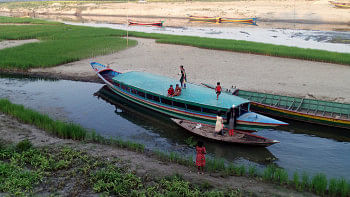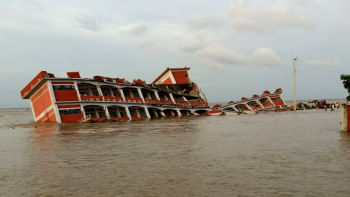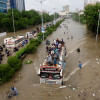Of river erosion and the people it displaces

Internally displaced persons (IDPs) are ones forced to flee their homes due to war, armed conflict, ethnic/religious persecution, and various forms of natural disasters. Lately, the impacts of climate change have joined the list of displacers. IDPs live in their own countries as displaced and homeless, without crossing an international boundary. They are found to migrate internally for employment and livelihood.
Although often used interchangeably, IDPs are different from refugees in many respects. Refugees are those who fled their homes for another country and are unwilling to return due to the violation of their human rights and/or fear of torture and intimidation. There are also "economic" refugees, who leave their countries in desperation due to economic hardships and for a better life. While IDP is an internal and descriptive category, refugees receive protection under international law and can't be forced to return home.
According to the United Nations High Commissioner for Refugees, by the end of 2022, there were around 108.4 million people worldwide who were forced to flee their homes. Of these, 62.5 million were IDPs. Bangladesh is currently placed 17th among countries with the largest numbers of IDPs. Many of the displacements in Bangladesh are owing to natural disasters such as flooding, river erosion, cyclones, and impacts of sea-level rise in coastal areas.
Between 2008 and 2014, as per estimates by the Internal Displacement Monitoring Centre (IDMC), close to five million people were displaced due to disasters in Bangladesh. Another study estimates that as many as 16 to 26 million people would likely be forced from their homes in the years between 2011 and 2050 due to climatic hazards, possibly leading to internal displacement and other forms of labour migration predominantly within the country.
According to experts, close to 70 upazilas in the country are affected and/or liable to annual riverbank erosion, displacing hundreds of thousands every year. Many are continually displaced by bank erosion; the extent and frequency of displacement at the individual and household levels are phenomenal. Despite this, there is no specific SOP for riverbank erosion and displacement responses.
In Bangladesh, the impact of all disasters such as floods, river erosion, and tropical cyclones are not the same. These differences matter in regard to preparedness, responses, and post-disaster rehabilitation. For instance, there is a Standard Operating Procedure (SOP) for district and local administrations during high floods, which often affect around one-third of the country, displacing – mostly temporarily – millions of people. The SOP requires the district administration concerned to undertake evacuation, provide temporary shelters, relief, and post-flood rehabilitation assistance, including agricultural recovery. There is also an array of cyclone preparedness methods such as early warnings, rescue, relief, and cyclone shelters for protection of the people and communities in coastal regions. As a result, there have been fewer reported deaths from natural disasters in recent times. Improved readiness and disaster response capacity have made floods less deadly. Both in the cases of floods and cyclones, most of the affected people are able to return home with assistance and rehabilitation support.
But displacement due to river erosion is an entirely different story. Despite the fact that the bulk of IDPs are victims of erosion, there is very little attention and support for these impoverished populations. Just like flooding, erosion is an endemic and recurrent natural disaster. According to experts, close to 70 upazilas in the country are affected and/or liable to annual riverbank erosion, displacing hundreds of thousands every year. Many are continually displaced by bank erosion; the extent and frequency of displacement at the individual and household levels are phenomenal. Despite this, there is no specific SOP for riverbank erosion and displacement responses. There is hardly any institutional support for erosion victims from national or local government agencies, compared to the response that flood and coastal cyclone victims get. Local government administrations rarely respond to or assist those displaced by erosion. And for the displaced populations, there are no homes to return to once those are devoured by the rivers.
The displaced households primarily rely on assistance from relatives and friends, and typically resettle within the local communities. Those who are unable to find a place resettle on available flood control embankments. Only a limited number of displaced households leave for the cities in search of livelihoods.
The extent of losses and damages caused by erosion displacement can be significantly reduced with an SOP dedicated to erosion displacement, resettlement, and rebuilding. Such an SOP should address socio-economic measures, including advance warning systems for potential erosion, training for increasing preparedness for loss reduction, recovery, resettlement, new livelihoods, and reformulation of land policies for alluvial and diluvial land to ensure access, and use of newly emerged char lands by former owners.
Needless to say, erosion victims and displaced households are on the margins of Bangladeshi society and are deprived of basic protection and assistance. They are dispossessed of their land resources and other property, and are unable to secure livelihoods for themselves. The SOP should help develop and strengthen the localised strategies of resilience and adaptive mechanisms for the socio-economic development of IDPs. The Disaster Management Bureau of the Ministry of Disaster Management and Relief should look into this urgently and extensively.
IDPs are one of the most vulnerable groups in the country. Bangladesh cannot afford to leave behind the IDPs in its journey to becoming a middle-income country. The government should put it high up on its agenda to prevent and manage internal displacement, protect those already displaced, collect data on the numbers and conditions of IDPs, support training on the rights of IDPs, and develop localised strategies for all kinds of climatic adaptation and development. This would require a comprehensive, IDP-specific legal instrument that affirms the rights of those who are internally displaced, while establishing minimum standards for the well-being of IDP communities.
Dr Mohammad Zaman is an international development and resettlement specialist. His latest edited book (with co-editors Reshmy Nair and Shi Guoqing) is titled 'Resettlement in Asian Countries: Legislation, Administration and Struggles for Rights.'

 For all latest news, follow The Daily Star's Google News channel.
For all latest news, follow The Daily Star's Google News channel. 










Comments